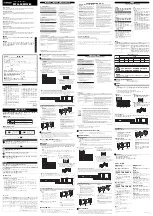
Chapter 4 Terminal Interfacing
“
n
”
0 to 2 specifies how your DSP sends characters to your terminal.
CASEDISP
allows you to set the case of the characters your DSP sends to your terminal; it offers three possible
modes:
CASEDISP
0
”As is” - characters’ case isn’t changed.
CASEDISP
1
”lower” - all characters are displayed in lowercase only.
CASEDISP
2
”UPPER” - all characters are displayed in uppercase only.
CASEDISP
has no effect on transmitted data from your DSP.
CMdtime
n
Default: 10 (1000 msec.)
Host: CQ
“
n
”
0 to 250specifies
TRANSPARENT
mode time-out value in 100-mS intervals. If “
n
” is 0 (zero), exit from
the Transparent mode requires sending the
BREAK
signal or interruption of power to the DSP.
CMDTIME
sets the time-out value in the Transparent mode. A guard time of “
n
” x 10 seconds allows escape to the
Command mode from the Transparent mode while permitting any character to be sent as data.
The same Command mode entry character
COMMAND
(default
CTRL-C
) is used to exit the Transparent mode,
although the procedure is different than from Converse mode. Three Command mode entry characters must be
entered less than “
n
” x 10 seconds apart—with no intervening characters—after a delay of “
n
” x 10 seconds
following the last characters typed.
The following diagram illustrates this timing:
Last First
Second
Third
DSP
now
Terminal Command Command Command
in
Command
Input Character Character
Character
mode
|
Entry
Entry Entry |
|
| | |
|
|
| | |
|
| <longer than
n
> | <shorter than
n
>
| <shorter than
n
>
| <——
n
——> |
COMmand
n
Default: $03 (
CTRL-C
)
Host: CN
“
n
”
0 to $7F (0 to 127 decimal) specifies an ASCII character code.
COMMAND
changes the Command mode entry character. Type the
COMMAND
character to enter the Command
mode from either the Converse or Transparent mode. After you enter the COMMAND character, the Command
prompt (
cmd:
) should appear, indicating successful entry into the Command mode. See
CMDTIME
.
CONVerse
( or
K
) Immediate
Command
Host: Not Supported
CONVERSE
is an immediate command that causes the DSP to switch from the Command mode to the Converse
mode. The letter
K
may also be used.
Once the DSP is in the Converse mode, all the characters typed into the keyboard are transmitted by your radio. To
return
the DSP to the Command mode, type the Command mode entry character, (
CTRL-C
).
CUstom
n
Default: $0A15
Host: Cu
4-8
September, 05
Summary of Contents for DSP-232
Page 120: ...Chapter 6 GPS Applications September 05 6 1...
Page 138: ...Chapter 7 Maildrop Operation 7 18 September 05...
Page 158: ......
Page 159: ...Chapter 8 ASCII and Baudot Operation September 05 8 1...
Page 185: ......
Page 186: ...Chapter 9 AMTOR Operation September 05 9 1...
Page 198: ......
Page 199: ...Chapter 10 Morse Operation September 05 10 1...
Page 207: ......
Page 208: ...Chapter 11 SIAM and NAVTEX Operation September 05 11 1...
Page 230: ......
Page 231: ...Chapter 12 PACTOR Operation September 05 12 1...
Page 240: ...Chapter 13 Troubleshooting September 05 13 9...
Page 254: ...Chapter 13 Troubleshooting 13 9...
Page 256: ...DSP 232 Manual Addendum September 05 AD 2...
Page 259: ...Appendix A Radio Connections Radio Connection Diagrams September 05 A 3...
Page 260: ...Appendix A Radio Connections A 4 September 05...
Page 261: ...Appendix A Radio Connections September 05 A 5...
Page 262: ...Appendix A Radio Connections A 6 September 05...
Page 263: ...Appendix A Radio Connections September 05 A 7...
Page 267: ...Appendix D Mailbox Upgrade September 05 D 2...
Page 268: ...Appendix E Schematics and Pictorial September 05 E 3...
















































